Atmospheric Correction of Multi-Spectral Littoral Images Using a PHOTONS/AERONET-Based Regional Aerosol Model
Abstract
1. Introduction
2. Materials and Methods
2.1. Site Description
2.2. AERONET Data
2.3. Classification of Air Masses back Trajectories
2.4. The In-Situ Based Atmospheric CORrection Algorithm (SACOR)
2.4.1. Algorithm Description
2.4.2. Assessment of SACOR performances
3. Results and Discussion
3.1. Variability of Aerosol Optical and Microphysical Properties
3.2. Identification of the Aerosol Origin at Synoptic Scale
3.3. Development of a Regional Aerosol Model (RAM)
3.4. Assessment of SACOR Performances
4. Conclusions
Acknowledgments
Author Contributions
Conflicts of Interest
References
- Newton, A.; Weichselgartner, J. Hotspots of coastal vulnerability: A DPSIR analysis to find societal pathways and responses. Estuar. Coast. Shelf Sci. 2014, 140, 123–133. [Google Scholar] [CrossRef]
- Nicholls, R.J. Planning for the impacts of sea level rise. Oceanography 2011, 24, 144–157. [Google Scholar] [CrossRef]
- Nicholls, R.J.; Wong, P.P.; Burkett, V.R.; Woodroffe, C.D.; Hay, J.E. Climate change and coastal vulnerability assessment: Scenarios for integrated assessment. Sustain. Sci. 2008, 3, 89–102. [Google Scholar] [CrossRef]
- Burkett, V.R.; Davidson, M.A. Coastal Impacts, Adaptation and Vulnerability: A Technical Input to the 2013 National Climate Assessment; Burkett, V.R., Davidson, M.A., Eds.; Island Press: Washington, DC, USA, 2012; p. 188. ISBN 978-1610914604. [Google Scholar]
- Le Treut, H. Les impacts du changement climatique en Aquitaine: Etat des lieux scientifique; Presses Universitaires de Bordeaux Pessac: Pessac, France, 2013. [Google Scholar]
- International Ocean-Colour Coordinating Group. Why Ocean Colour? The Societal Benefits of Ocean-Colour Technology; Platt, T., Hoepffner, N., Stuart, V., Brown, C., Eds.; International Ocean-Colour Coordinating Group: Dartmouth, NS, Canada, 2008. [Google Scholar]
- International Ocean-Colour Coordinating Group. Mission Requirements for Future Ocean-Colour Sensors; McClain, C.R., Meister, G., Eds.; International Ocean-Colour Coordinating Group: Dartmouth, NS, Canada, 2012. [Google Scholar]
- Klemas, V. Airborne remote sensing of coastal features and processes: An overview. J. Coastal. Res. 2013, 29, 239–255. [Google Scholar] [CrossRef]
- Mouw, C.B.; Greb, S.; Aurin, D.; DiGiacomo, P.M.; Lee, Z.; Twardowski, M.; Binding, C.; Hu, C.; Ma, R.; Moore, T.; et al. Aquatic color radiometry remote sensing of coastal and inland waters: Challenges and recommendations for future satellite missions. Remote Sens. Environ. 2015, 160, 15–30. [Google Scholar] [CrossRef]
- Pahlevan, N.; Lee, Z.; Hu, C.; Schott, J.R. Diurnal remote sensing of coastal/oceanic waters: A radiometric analysis for geostationary coastal and air pollution events. Appl. Opt. 2014, 53, 648–665. [Google Scholar] [CrossRef] [PubMed]
- Roy, D.P.; Wulder, M.A.; Loveland, T.R.; Woodcock, C.E.; Allen, R.G.; Anderson, M.C.; Helder, D.; Irons, J.R.; Johnson, D.M.; Kennedy, R.; et al. Landsat-8: Science and product vision for terrestrial global change research. Remote Sens. Environ. 2014, 145, 154–172. [Google Scholar] [CrossRef]
- Capo, S.; Lubac, B.; Marieu, V.; Robinet, A.; Bru, D.; Bonneton, P. Assessment of the decadal morphodynamic evolution of a mixed energy inlet using ocean color remote sensing. Ocean Dyn. 2014, 64, 1517–1530. [Google Scholar] [CrossRef]
- Vanhellemont, Q.; Ruddick, K. Turbid wakes associated with offshore wind turbines observed with Landsat 8. Remote Sens. Environ. 2014, 145, 105–115. [Google Scholar] [CrossRef]
- Hagolle, O.; Huc, M.; Pascual, D.V.; Dedieu, G. A multi-temporal and multi-spectral method to estimate aerosol thickness over land, for the atmospheric correction of Formosat-2, LandSat, VENμs, and Sentinel-2 images. Remote Sens. 2015, 7, 2668–2691. [Google Scholar] [CrossRef]
- Gordon, H.R.; Wang, M. Retrieval of water-leaving radiance and aerosol optical thickness over the oceans with SeaWIFS: A preliminary algorithm. Appl. Opt. 1994, 33, 443–452. [Google Scholar] [CrossRef] [PubMed]
- Ruddick, K.; Ovidio, F.; Rijkeboer, M. Atmospheric correction of SeaWIFS imagery for turbid coastal and inland waters. Appl. Opt. 2000, 39, 897–912. [Google Scholar] [CrossRef] [PubMed]
- Wang, M.; Shi, W. Estimation of ocean contribution at the MODIS near-infrared wavelengths along the east coast of the U.S.: Two case studies. Geophys. Res. Lett. 2005, 32, L13606. [Google Scholar] [CrossRef]
- Jamet, C.; Loisel, H.; Kuchinke, C.P.; Ruddick, K.; Zibordi, G.; Feng, H. Comparison of three SeaWIFS atmospheric correction algorithms for turbid waters using AERONET-OC measurements. Remote Sens. Environ. 2011, 115, 1955–1965. [Google Scholar] [CrossRef]
- Vanhellemont, Q.; Ruddick, K. Advantages of high quality SWIR bands for ocean colour processing: Examples from Landsat-8. Remote Sens. Environ. 2015, 161, 89–106. [Google Scholar] [CrossRef]
- Wang, M. Remote sensing of the ocean contributions from ultraviolet to nearinfrared using the shortwave infrared bands: Simulations. Appl. Opt. 2007, 46, 1535–1547. [Google Scholar] [CrossRef] [PubMed]
- He, X.; Bai, Y.; Pan, D.; Huang, N.; Dong, X.; Chen, J.; Chen, C.-T.A.; Cui, Q. Using geostationary satellite ocean color data to map the diurnal dynamics of suspended particulate matter in coastal waters. Remote Sens. Environ. 2013, 133, 225–239. [Google Scholar] [CrossRef]
- Hu, C.; Carder, K.L.; Muller-Karger, F.E. Atmospheric correction of SeaWIFS imagery over turbid coastal waters. Remote Sens. Environ. 2000, 74, 195–206. [Google Scholar] [CrossRef]
- Shanmugan, P.; Ahn, Y. New atmospheric correction technique to retrieve the ocean colour from SeaWiFS imagery in complex coastal waters. J. Opt. A Pure Appl. Opt. 2007, 9, 511–530. [Google Scholar] [CrossRef]
- Kuchinke, C.P.; Gordon, H.R.; Franz, B.A. Spectral optimization for constituent retrieval in Case II waters I: Implementation and performance. Remote Sens. Environ. 2009, 13, 571–587. [Google Scholar] [CrossRef]
- Kuchinke, C.P.; Gordon, H.R.; Harding, L.W., Jr.; Voss, K.J. Spectral optimization for constituent retrieval in Case II waters II: Validation study in the Chesapeake Bay. Remote Sens. Environ. 2009, 113, 610–621. [Google Scholar] [CrossRef]
- Brajard, J.; Santer, R.; Crépon, M.; Thiria, S. Atmospheric correction of MERIS data for case-2 waters using a neuro-variational inversion. Remote Sens. Environ. 2012, 126, 51–61. [Google Scholar] [CrossRef]
- Doerffer, R.; Schiller, H. The MERIS Case 2 algorithm. Int. J. Remote Sens. 2007, 28, 517–535. [Google Scholar] [CrossRef]
- Schroeder, T.; Behnert, I.; Schaale, M.; Fischer, J.; Doerffer, R. Atmospheric correction algorithm for MERIS above case-2 waters. Int. J. Remote Sens. 2007, 28, 1469–1486. [Google Scholar] [CrossRef]
- Stumpf, R.P.; Arnone, R.A.; Gould, R.W.; Ransibrahmanakul, V. A partly coupled ocean-atmosphere model for retrieval of water-leaving radiance from SeaWIFS in coastal waters. NASA Tech. Memo. 2003, 206892, 51–59. [Google Scholar]
- Bailey, S.W.; Franz, B.A.; Werdell, P.J. Estimation of near-infrared water-leaving reflectance for satellite ocean color data processing. Opt. Express 2010, 18, 7521–7527. [Google Scholar] [CrossRef] [PubMed]
- Goyens, C.; Jamet, C.; Ruddick, K.G. Spectral relationships for atmospheric correction. I. Validation of red and near infra-red marine reflectance relationships. Opt. Express 2013, 21, 21162–21175. [Google Scholar] [CrossRef] [PubMed]
- Goyens, C.; Jamet, C.; Ruddick, K.G. Spectral relationships for atmospheric correction. II. Improving NASA's standard and MUMM near infra-red modeling schemes. Opt. Express 2013, 21, 21176–21187. [Google Scholar] [CrossRef] [PubMed]
- Wang, M.; Shi, W.; Jiang, L. Atmospheric correction using near-infrared bands for satellite ocean color data processing in the turbid western pacific region. Opt. Express 2012, 20, 741–753. [Google Scholar] [CrossRef] [PubMed]
- Jiang, L.; Wang, M. Improved near-infrared ocean reflectance correction algorithm for satellite ocean color data processing. Opt. Express 2014, 22, 21657–21678. [Google Scholar] [CrossRef] [PubMed]
- Smirnov, A.; Holben, B.; Kaufman, Y.J.; Dubovik, O.; Eck, T.F.; Slutsker, I.; Pietras, C.; Halthore, R.N. Optical properties of atmospheric aerosol in marine environments. J. Atmos. Sci. 2002, 59, 501–523. [Google Scholar] [CrossRef]
- Dubovik, O.; Holben, B.; Eck, T.F.; Smirnov, A.; Kaufman, Y.J.; King, M.D.; Tanre, D.; Slutsker, I. Variability of absorption and optical properties of key aerosol types observed in worldwide locations. J. Atmos. Sci. 2002, 59, 590–608. [Google Scholar] [CrossRef]
- Martiny, N.; Frouin, R.; Santer, R. Radiometric calibration of SeaWIFS in the near infrared. Appl. Opt. 2005, 44. [Google Scholar] [CrossRef]
- Ahmad, Z.; Franz, B.A.; McClain, C.R.; Kwiatkowska, E.J.; Werdell, J.; Shettle, E.P.; Holben, B.N. New aerosol models for the retrieval of aerosol optical thickness and normalized water-leaving radiances from the SeaWiFS and MODIS sensors over coastal regions and open oceans. Appl. Opt. 2010, 49, 5545–5560. [Google Scholar] [CrossRef] [PubMed]
- Bassani, C.; Manzo, C.; Braga, F.; Bresciani, M.; Giardino, C.; Alberotanza, L. The impact of the microphysical properties of aerosol on the atmospheric correction of hyperspectral data in coastal waters. Atmos. Meas. Tech. 2015, 8, 1593–1604. [Google Scholar] [CrossRef]
- Vermote, E.; Justice, C.; Claverie, M.; Franch, B. Preliminary analysis of the performance of the Landsat 8/OLI land surface reflectance product. Remote Sens. Environ. 2016, 185, 46–56. [Google Scholar] [CrossRef]
- Glé, C.; Del Almo, Y.; Sautour, B.; Labore, P.; Chardy, P. Variability of nutrients and phytoplankton primary production in a shallow macrotidal coastal ecosystem (Arcachon Bay, France). Estuar. Coast. Shelf Sci. 2008, 76, 642–656. [Google Scholar] [CrossRef]
- Dubois, S.; Savoye, N.; Gremare, A.; Plus, M.; Charlier, K.; Beltoise, A.; Blanchet, H. Origin and composition of sediment organic matter in a coastal semi-enclosed ecosystem: An elemental and isotopic study at the ecosystem space scale. J. Mar. Syst. 2012, 94, 64–73. [Google Scholar] [CrossRef]
- Polsenaere, P.; Abril, G. Modelling CO2 degassing from small acidic rivers using water pCO2, DIC and δ13C-DIC data. Geochim. Cosmochim. Acta 2012, 91, 220–239. [Google Scholar] [CrossRef]
- Puillat, I.; Lazure, P.; Jégou, A.-M.; Lampert, L.; Miller, P. Mesoscale hydrological variablity induced by northwesterly wind on the French continental shelf of the Bay of Biscay. Sci. Mar. 2006, 70, 15–26. [Google Scholar] [CrossRef]
- Robinet, A.; Castelle, B.; Idier, D.; Le Cozannet, G.; Déqué, M.; Charles, E. Statistical modeling of interannual shoreline change driven by north Atlantic climate variability spanning 2000–2014 in the Bay of Biscay. Geo-Mar. Lett. 2016, 36, 479–490. [Google Scholar] [CrossRef]
- LA QUALITÉ DE L’AIR EN NOUVELLE-AQUITAINE AIRAQ. Available online: http://www.atmo-nouvelleaquitaine.org/publications/bilan-des-donnees-aquitaine-2015 (accessed on 7 March 2016).
- Dubovik, O.; King, M.D. A flexible inversion algorithm for retrieval of aerosol optical properties from Sun and sky radiance measurements. J. Geophys. Res. 2000, 105, 20673–20696. [Google Scholar] [CrossRef]
- Holben, B.N.; Eck, T.F.; Slutsker, I.; Tanré, D.; Buis, J.P.; Setzer, A.; Vermote, E.; Reagan, J.A.; Kaufman, Y.; Nakajima, T.; et al. AERONET—A federated instrument network and data archive for aerosol characterization. Remote Sens. Environ. 1998, 66, 1–16. [Google Scholar] [CrossRef]
- Holben, B.N.; Tanré, D.; Smirnov, A.; Eck, T.F.; Slutsker, I.; Abuhassan, N.; Newcomb, W.W.; Schafer, J.; Chatenet, B.; Lavenue, F.; et al. An emerging ground-based aerosol climatology: Aerosol optical depth from AERONET. J. Geophys. Res. 2001, 106, 12067–12097. [Google Scholar] [CrossRef]
- O’Neill, N.T.; Eck, T.F.; Smirnov, A.; Holben, B.N.; Thulasiraman, S. Spectral discrimination of coarse and fine mode optical depth. J. Geophys. Res. 2003, 108. [Google Scholar] [CrossRef]
- Draxler, R.R.; Hess, G.D. Description of the HYSPLIT_4 Modeling System. Available online: http://warn.arl.noaa.gov/documents/reports/arl-224.pdf (accessed on December 1997).
- Draxler, R.R. HYSPLIT4 User’s Guide. Available online: http://www.villasmunta.it/pdf/User_guide.pdf (accessed on June 1999).
- Stein, A.F.; Draxler, R.R.; Rolph, G.D.; Stunder, B.J.B.; Cohen, M.D.; Ngan, F. NOAA’s HYSPLIT atmospheric transport and dispersion modeling system. Bull. Am. Meteorol. Soc. 2015, 96, 2059–2077. [Google Scholar] [CrossRef]
- Toledano, C.; Cachorro, V.E.; De Frutos, A.M.; Torres, B.; Berjon, A.; Sorribas, M.; Stone, R.S. Airmass classification and analysis of aerosol types at El Arenosillo (Spain). J. Appl. Meteorol. Clim. 2009, 48. [Google Scholar] [CrossRef]
- Draxler, R.R.; Stunder, B.; Rolph, G.; Stein, A.; Taylor, A. HYSPLIT_4 User’s Guide; NOAA Air Resources Laboratory: Silver Spring, MD, USA, 2012. [Google Scholar]
- Draxler, R.R.; Stunder, B.; Rolph, G.; Stein, A.; Taylor, A. HYSPLIT Tutorial; NOAA Air Resources Laboratory: Silver Spring, MD, USA, 2012. [Google Scholar]
- Su, L.; Yuan, Z.; Fung, J.C.H.; Lau, A.K.H. A comparison of HYSPLIT backward trajectories generated from two GDAS datasets. Sci. Total Environ. 2015, 506, 527–537. [Google Scholar] [CrossRef] [PubMed]
- Gordon, H.R. Atmospheric correction of ocean color imagery in the Earth Observing System era. J. Geophys. Res. 1997, 102, 17081–17106. [Google Scholar] [CrossRef]
- Morel, A.; Gentili, G. Diffuse reflectance of oceanic waters. III. Implication of bidirectionality for the remote-sensing problem. Appl. Opt. 1996, 35, 4850–4862. [Google Scholar] [CrossRef] [PubMed]
- Frouin, R.; Pelletier, B. Bayesian methodology for inverting satellite ocean-color data. Remote Sens. Environ. 2015, 159, 332–360. [Google Scholar] [CrossRef]
- Hanel, G. The properties of atmospheric aerosol particles as functions of the relative humidity at thermodynamic equilibrium with the surrounding moist air. Adv. Geophys. 1976, 19, 73–188. [Google Scholar] [CrossRef]
- Shettle, E.P.; Fenn, R.W. Models for the Aerosols of the Lower Atmosphere and the Effects of Humidity Variations on Their Optical Properties. Available online: http://web.gps.caltech.edu/~vijay/Papers/Aerosol/SF79-Aerosol-Models-part1of4.PDF (accessed 20 September 1979).
- Deuzé, J.L.; Herman, M.; Santer, R. Fourier series expansion of the transfer equation in the atmosphere-ocean system. J. Quant. Spectrosc. Radiat. 1989, 41, 483–494. [Google Scholar] [CrossRef]
- Lenoble, J.; Herman, M.; Deuzé, J.L.; Lafrance, B.; Santer, R.; Tanré, D. A successive order of scattering code for solving the vector equation of transfer in the earth's atmosphere with aerosols. J. Quant. Spectrosc. Radiat. 2007, 107, 479–507. [Google Scholar] [CrossRef]
- Rahman, H.; Dedieu, G. SMAC: A simplified method for the atmospheric correction of satellite measurements in the solar spectrum. Int. J. Remote Sens. 1994, 15, 123–143. [Google Scholar] [CrossRef]
- Bru, D. Corrections atmosphériques pour capteurs à très haute résolution spatiale en zone littorale. Ph.D. Thesis, Univ. Bordeaux, Pessac, France, December 2015. [Google Scholar]
- Pahlevan, N.; Schott, J.R. Leveraging EO-1 to evaluate capability of new generation of landsat sensors for coastal/inland water studies. IEEE J. STARS 2013, 6, 360–374. [Google Scholar] [CrossRef]
- USGS. Available online: http://earthexplorer.usgs.gov/ (accessed on 31 July 2017).
- Novoa, S.; Doxaran, D.; Ody, A.; Vanhellemont, Q.; Lafon, V.; Lubac, B.; Gernez, P. Atmospheric corrections and multi-conditional algorithm for multi-sensor remote sensing of suspended particulate matter in low-to-high turbidity levels coastal waters. Remote Sens. 2017, 9. [Google Scholar] [CrossRef]
- Ruddick, K.; De Cauwer, V.; Park, Y.-J.; Moore, G. Seaborne measurements of near infrared water-leaving reflectance: The similarity spectrum for turbid waters. Limnol. Oceanogr. 2006, 51, 1167–1179. [Google Scholar] [CrossRef]
- Lubac, B.; Loisel, H. Variability and classification of remote sensing reflectance spectra in the eastern English Channel and southern North Sea. Remote Sens. Environ. 2007, 110, 45–58. [Google Scholar] [CrossRef]
- Vermote, E.; Tanré, D.; Deuzé, J.; Herman, M.; Morcrette, J.; Kotchenova, S. Second Simulation of a Satellite Signal in the Solar Spectrum-Vector (6SV); 6S User Guide Version; NASA Goddard Space Flight Center: Greenbelt, MD, USA, 2006. [Google Scholar]
- Theia. Available online: http://spirit.cnes.fr/resto/Landsat (accessed on January 2014).
- Hagolle, O.; Dedieu, G.; Mougenot, B.; Debaecker, V.; Duchemin, B.; Meygret, A. Correction of aerosol effects on multi-temporal images acquired with constant viewing angles: Application to Formosat-2 images. Remote Sens. Environ. 2008, 112, 1689–1701. [Google Scholar] [CrossRef]
- Kotchenova, A.Y.; Vermote, E.; Matarrese, R.; Klemm, F.J., Jr. Validation of a vector version of the 6S radiative transfer code for atmospheric correction of satellite data. Part I: Path radiance. Appl. Opt. 2006, 45, 6762–6774. [Google Scholar] [CrossRef] [PubMed]
- Barnaba, F.; Angelini, F.; Curci, G.; Gobbi, G.P. An important fingerprint of wildfires on the European aerosol load. Atmos. Chem. Phys. 2011, 11, 10487–10501. [Google Scholar] [CrossRef]
- Piazzola, J.; Forget, P.; Lafon, C.; Despiau, S. Spatial variation of sea-spray fluxes over a Mediterranean coastal zone using a sea-state model. Bound. Lay Meteorol. 2009, 132, 167–183. [Google Scholar] [CrossRef]
- Piazzola, J.; Tedeschi, G.; Demoisson, A. A model for the transport of sea-spray aerosols in the coastal zone. Bound. Lay Meteorol. 2015, 155, 329–350. [Google Scholar] [CrossRef]
- Pace, G.; Di Sarra, A.; Meloni, D.; Piacentino, S.; Chamard, P. Aerosol optical properties at Lampedusa (Central Mediterranean). 1. Influence of transport and identification of different aerosol types. Atmos. Chem. Phys. 2006, 6, 697–713. [Google Scholar] [CrossRef]
- Tan, F.; Lim, H.S.; Abdullah, K.; Yoon, T.L.; Holben, B. AERONET data-based determination of aerosol types. Atmos. Pollut. Res. 2015, 6, 682–695. [Google Scholar] [CrossRef]
- Lyamani, H.; Valenzuela, A.; Perez-Ramirez, D.; Toledano, C.; Granados-Munoz, M.J.; Olmo, F.J.; Alados-Arboledas, L. Aerosol properties over the western Mediterranean basin: Temporal and spatial variability. Atmos. Chem. Phys. 2015, 15, 2473–2486. [Google Scholar] [CrossRef]
- Toledano, C.; Sorribas, M.; Berjon, A.; De La Morena, B.A.; De Frutos, M.; Gouloub, P. Aerosol optical depth and Angstrom exponent climatology at El Arenosillo AERONET site (Huelva, Spain). Q. J. R. Meteorol. Soc. 2007, 133, 795–807. [Google Scholar] [CrossRef]
- Kaskaoutis, D.G.; Kambezidis, H.D.; Hatzianastassiou, N.; Kosmopoulos, P.G.; Badarinath, K.V.S. Aerosol climatology: On the discrimination of aerosol types over four AERONET sites. Atmos. Chem. Phys. Discuss. 2007, 7, 6357–6411. [Google Scholar] [CrossRef]
- Butel, R.; Dupuis, H.; Bonneton, P. Spatial variability of wave conditions on the French Atlantic coast using in-situ data. J. Coast. Res. 2002, 36, 96–108. [Google Scholar]
- Senechal, N.; Coco, G.; Castelle, B.; Marieu, V. Storm impact on the seasonal shoreline dynamics of a meso- to macrotidal open sandy beach (Biscarrosse, France). Geomorphology 2015, 228, 448–461. [Google Scholar] [CrossRef]
- Pahlevan, N.; Scott, J.R.; Franz, B.A.; Zibordi, G.; Markham, B.; Bailey, S.; Schaaf, C.B.; Ondrusek, M.; Greb, S.; Strait, C.M. Landsat 8 remote sensing reflectance (Rrs) products: Evaluations, intercomparisons, and enhancements. Remote Sens. Environ. 2017, 190, 289–301. [Google Scholar] [CrossRef]
- Wettle, B.; Brando, V.E.; Dekker, A.G. A methodology for retrieval of environmental noise equivalent spectra applied to four Hyperion scenes of the same tropical coral reef. Remote Sens. Environ. 2004, 93, 188–197. [Google Scholar] [CrossRef]
- Franz, B.A.; Bailey, S.W.; Kuring, N.; Werdell, P.J. Ocean color measurements with the Operational Land Imager on Landsat-8: Implementation and evaluation in SeaDAS. J. Appl. Remote Sens. 2015, 9. [Google Scholar] [CrossRef]
- Nobileau, D.; Antoine, D. Detection of blue-absorbing aerosols using near infrared and visible (ocean color) remote sensing observations. Remote Sens. Environ. 2005, 95, 368–387. [Google Scholar] [CrossRef]
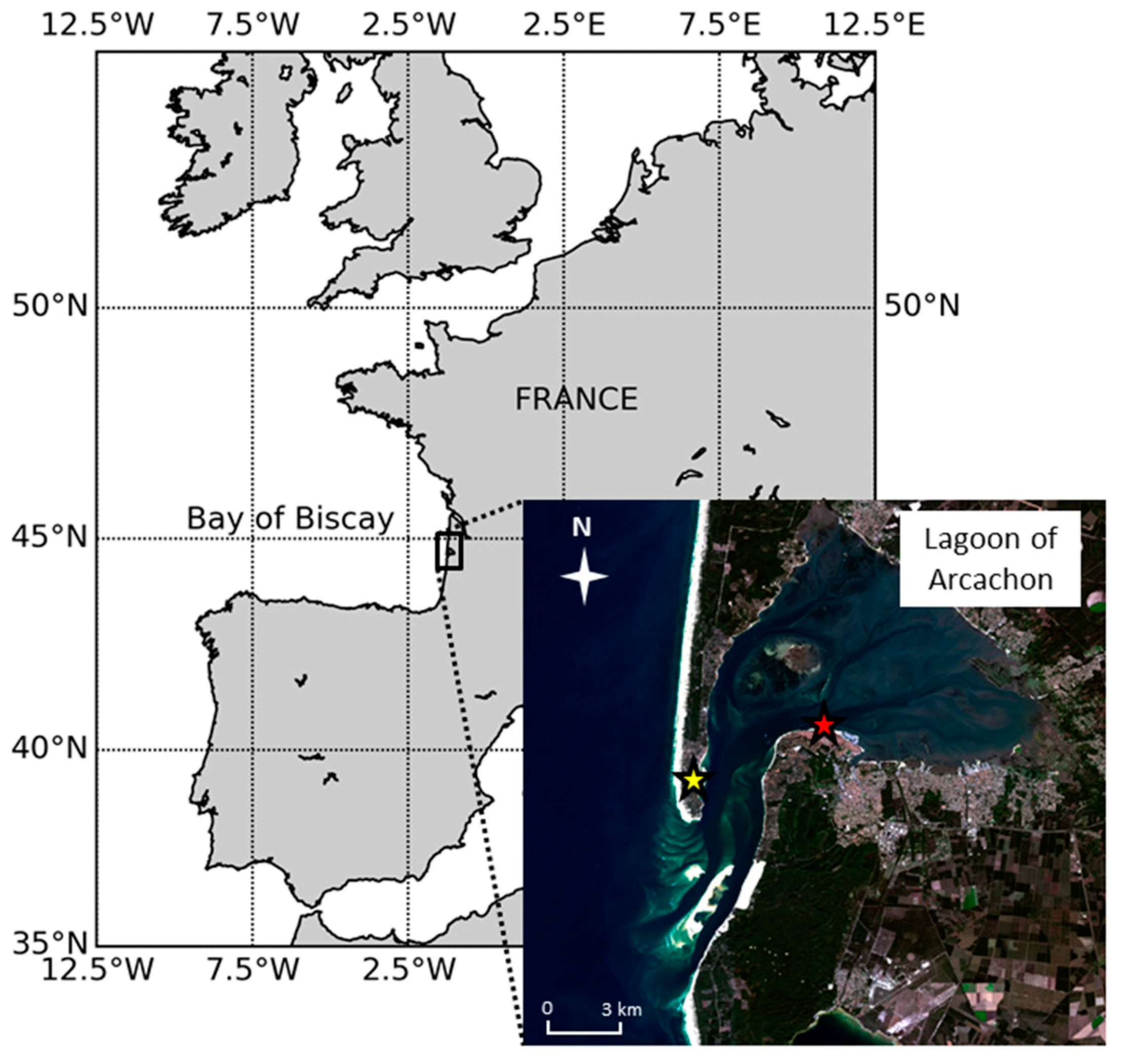
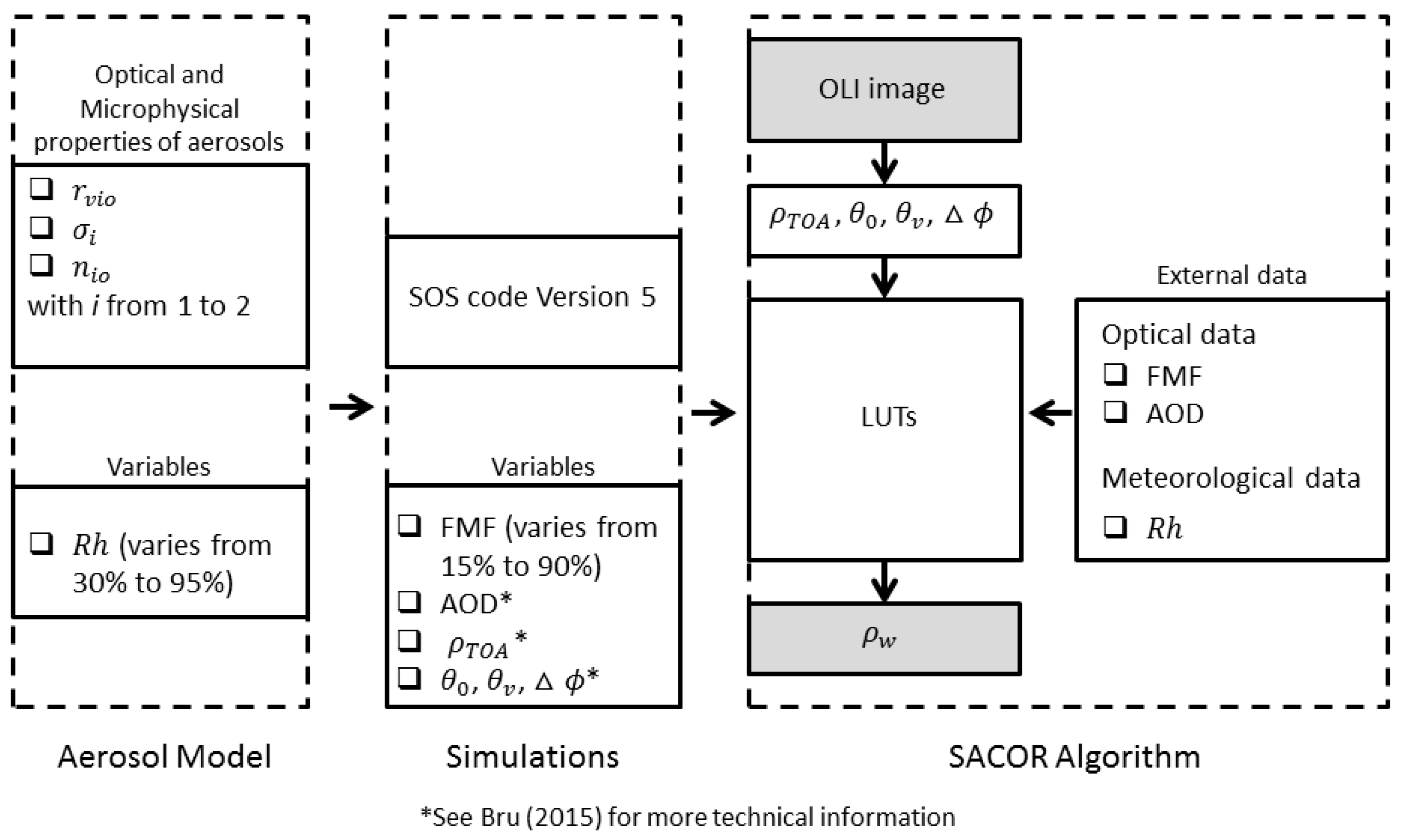
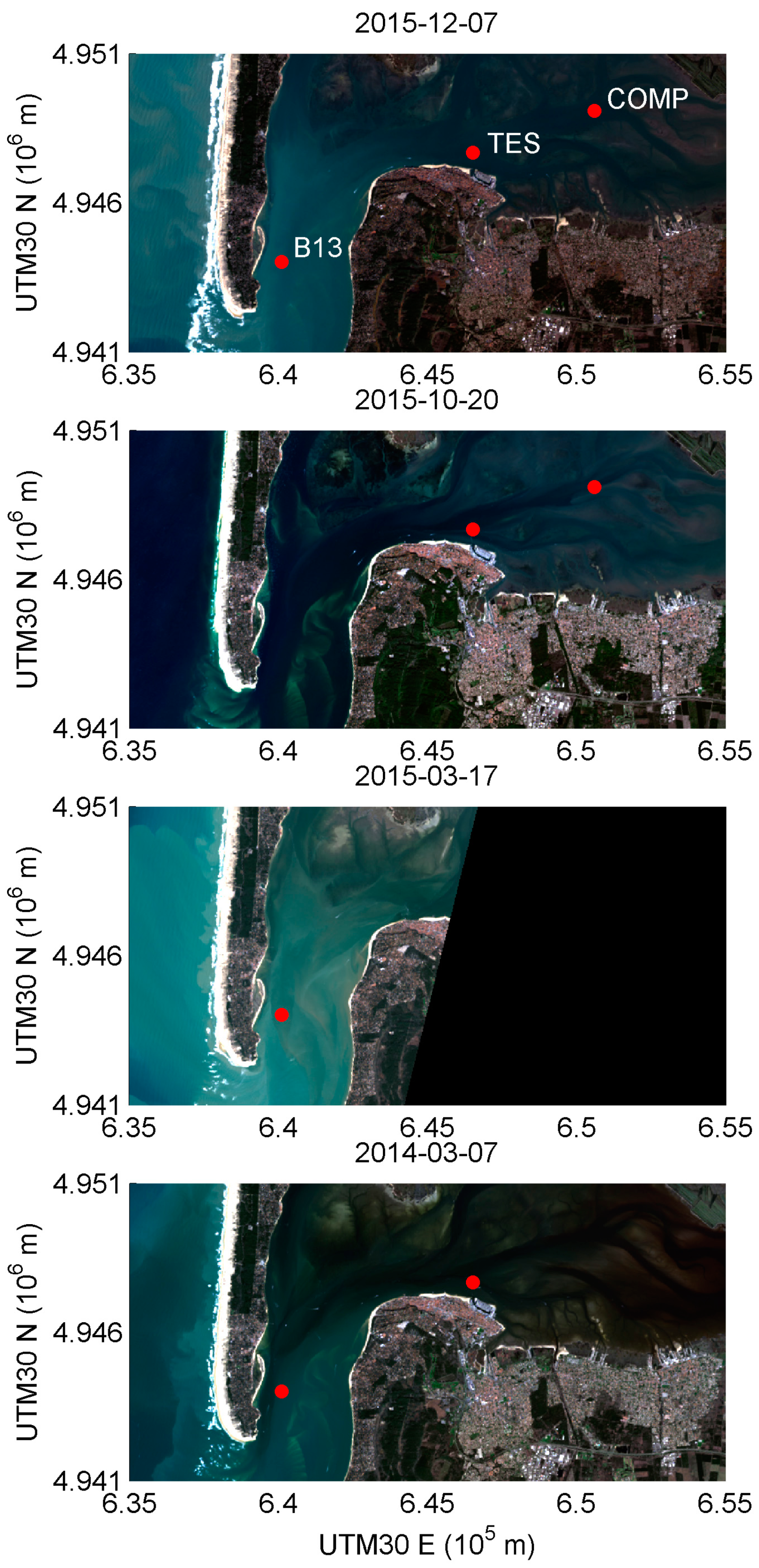
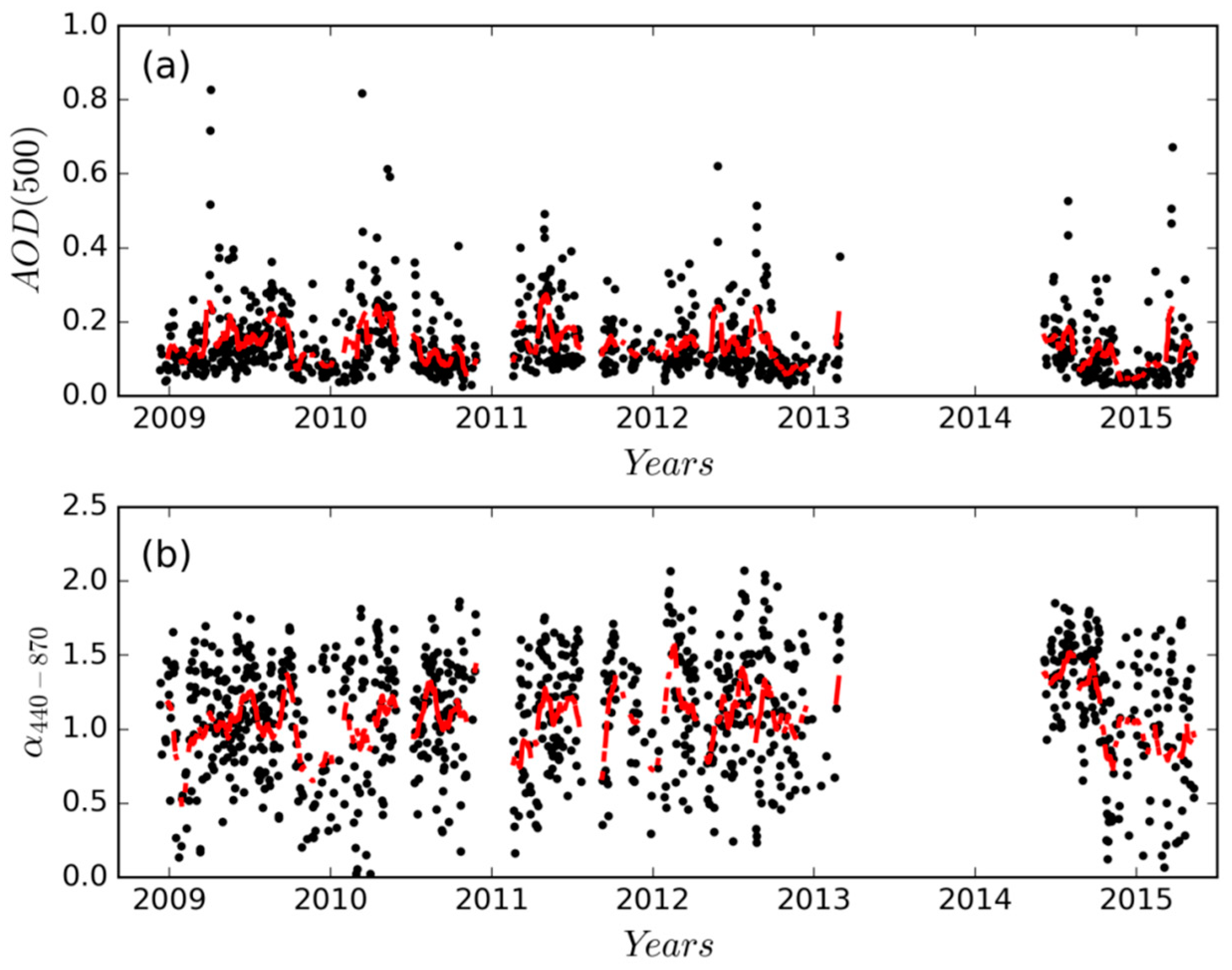

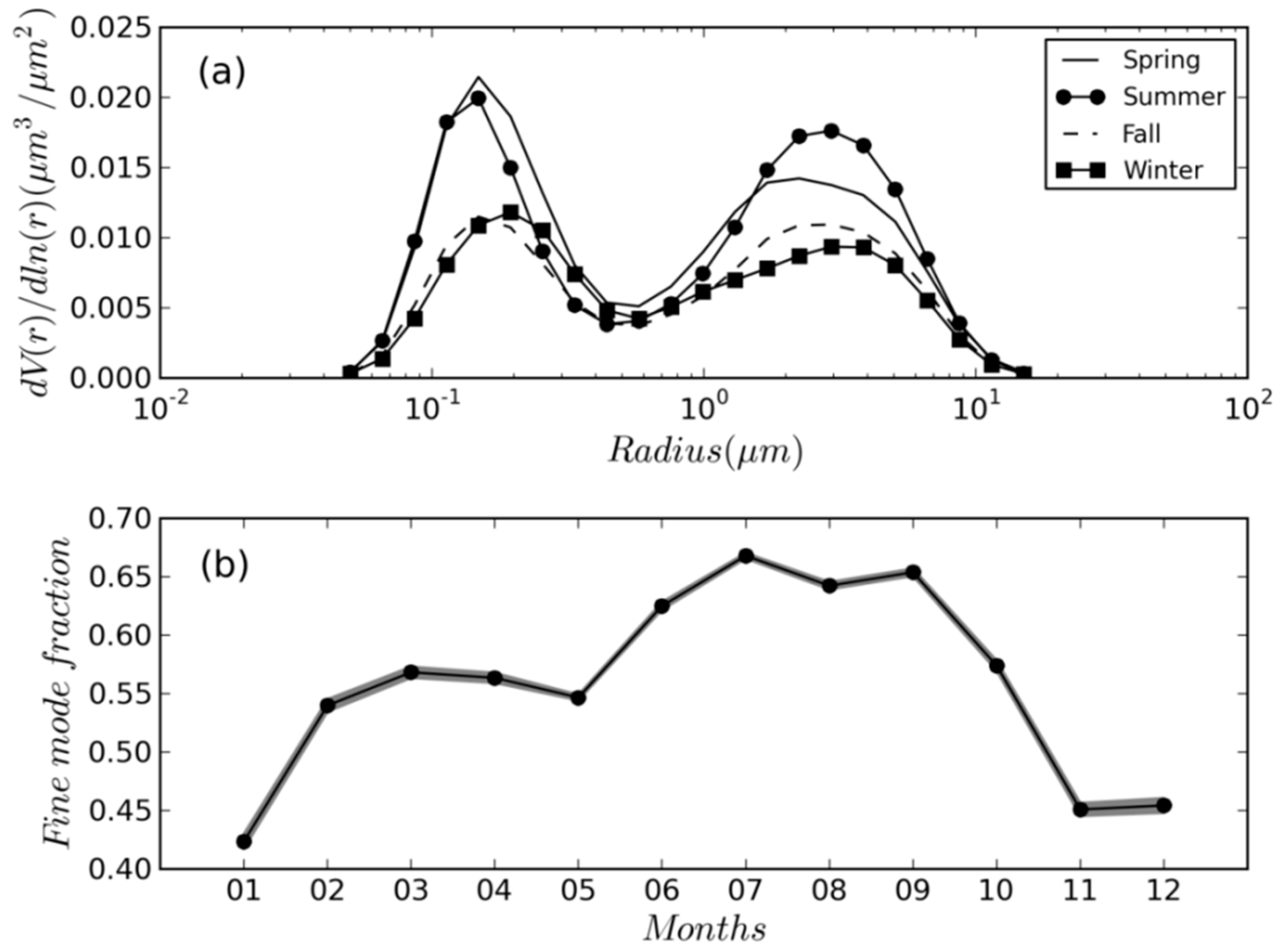


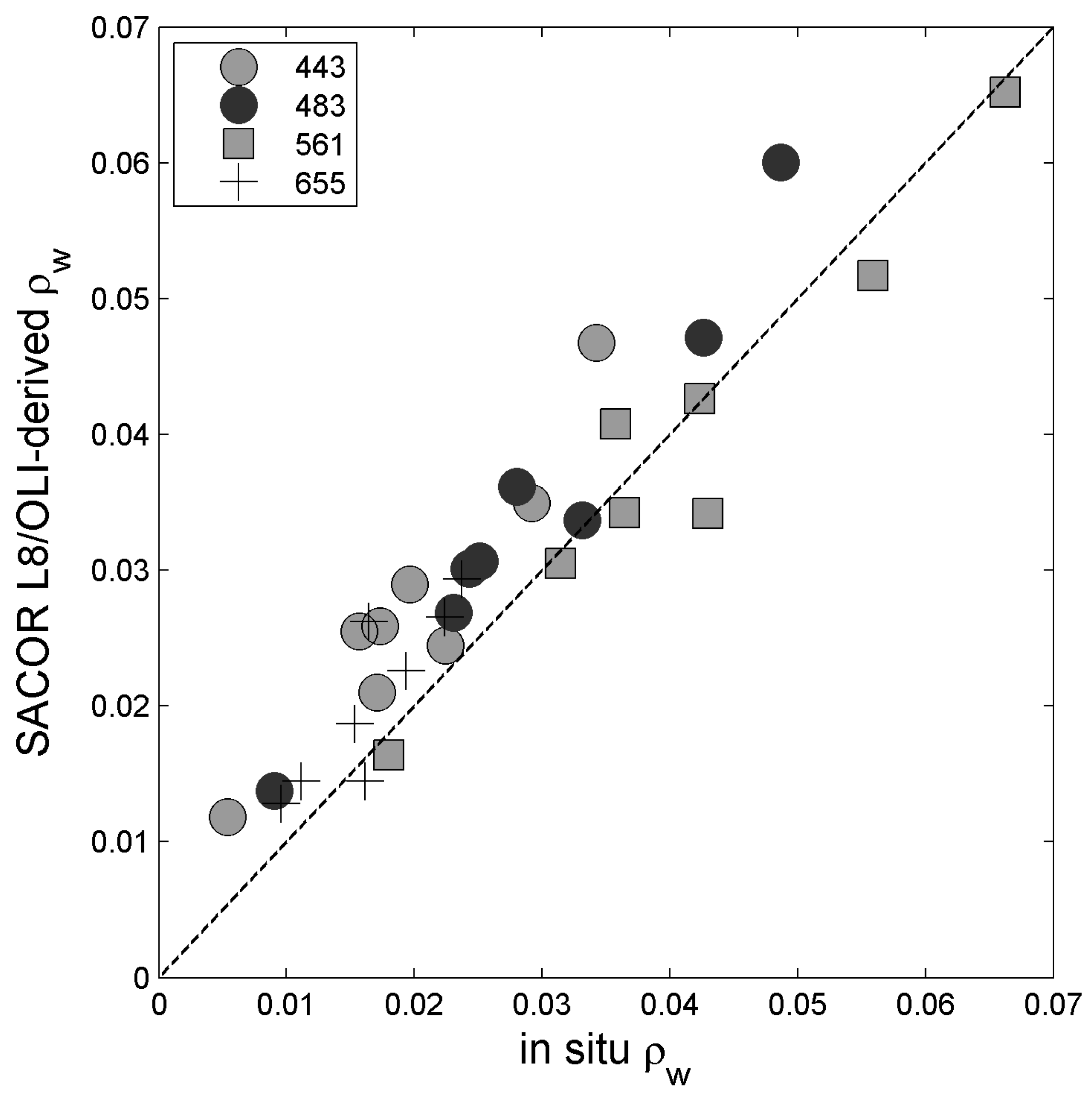

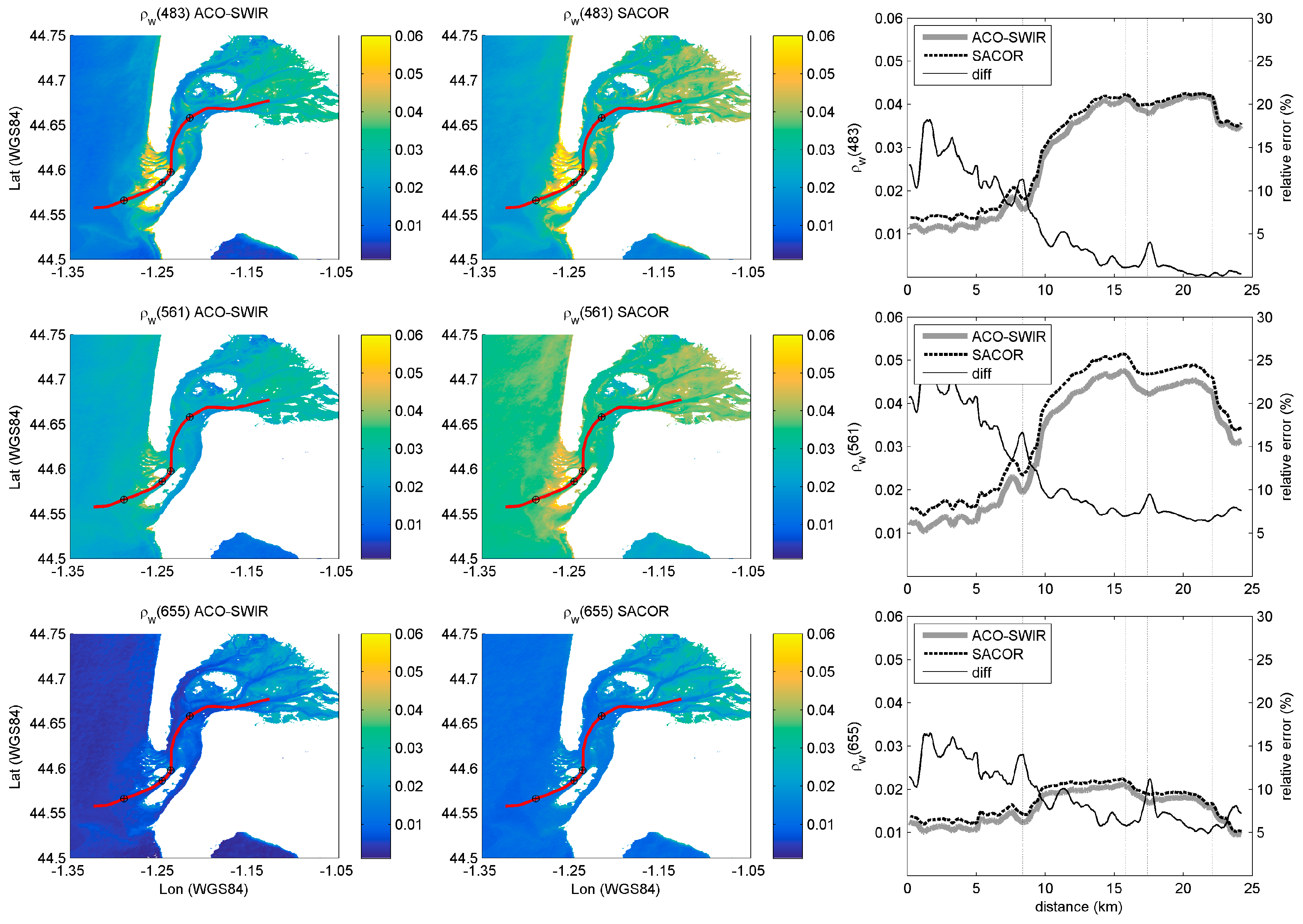
| Image | Date/Time (UTM) | AOD | Rh | ||
|---|---|---|---|---|---|
| #1 | LC08_L1TP_200029_20140307_20170425_01_T1 | 2014-03-07 10:49 | 0.14 | 1.09 | 73% |
| #2 | LC08_L1TP_201029_20150317_20170412_01_T1 | 2015-03-17 10:54 | 0.08 | 1.70 | 65% |
| #3 | LC08_L1TP_200029_20151020_20170403_01_T1 | 2015-10-20 10:48 | 0.06 | 1.50 | 71% |
| #4 | LC08_L1TP_200029_20151207_20170401_01_T1 | 2015-12-07 10:48 | 0.07 | 1.40 | 81% |
| N | AOD | α440–870 | CM | BU | DU | MM | MC | |
|---|---|---|---|---|---|---|---|---|
| Threshold Values | - | - | - | AOD < 0.1 α440–870 < 1.0 | AOD > 0.2 α440–870 > 1.0 | AOD > 0.2 α440–870 < 1.0 | 0.1 < AOD < 0.2 α440–870 < 1.0 | AOD < 0.2 α440–870 > 1.0 |
| Spring | 266 | 0.18 (0.11) | 1.11 (0.36) | 14 | 22 | 8 | 17 | 39 |
| Summer | 297 | 0.14 (0.08) | 1.20 (0.36) | 9 | 15 | 4 | 11 | 61 |
| Fall | 213 | 0.11 (0.06) | 1.08 (0.41) | 23 | 7 | 2 | 14 | 54 |
| Winter | 215 | 0.13 (0.10) | 1.07 (0.47) | 26 | 13 | 1 | 15 | 45 |
| Total | 991 | 0.14 (0.10) | 1.12 (0.40) | 17 | 15 | 4 | 14 | 50 |
| AOD | FMF | CM | BU | DU | MM | MC | ||
|---|---|---|---|---|---|---|---|---|
| Class 1 | 0.12 (0.06) | 0.96 (0.40) | 56 (19) | 27 | 7 | 2 | 21 | 43 |
| Class 2 | 0.20 (0.09) | 1.24 (0.35) | 65 (18) | 6 | 26 | 7 | 10 | 51 |
| Class 3 | 0.12 (0.10) | 1.07 (0.36) | 56 (19) | 29 | 8 | 2 | 14 | 47 |
| Class 4 | 0.18 (0.14) | 1.36 (0.31) | 74 (17) | 8 | 28 | 2 | 5 | 57 |
| Class 5 | 0.13 (0.07) | 1.14 (0.33) | 61 (15) | 14 | 10 | 8 | 10 | 58 |
| Class 6 | 0.09 (0.04) | 0.52 (0.34) | 36 (16) | 52 | 0 | 0 | 40 | 8 |
| Class 7 | 0.09 (0.03) | 0.77 (0.31) | 48 (16) | 53 | 0 | 0 | 30 | 17 |
| 443 nm | 483 nm | 561 nm | 655 nm | Mean | |
|---|---|---|---|---|---|
| SACOR | 46 | 21 | 7 | 22 | 24 |
| ACO-SWIR | 21 | 13 | 27 | 14 | 19 |
| ACO-NIR | 77 | 32 | 36 | 22 | 42 |
| 6SV-MAR | 96 | 35 | 17 | 32 | 45 |
| 6SV-CON | 74 | 40 | 18 | 65 | 49 |
| 6SV-TRO | 80 | 27 | 12 | 24 | 36 |
| MACCS | 78 | 45 | 22 | 38 | 46 |
© 2017 by the authors. Licensee MDPI, Basel, Switzerland. This article is an open access article distributed under the terms and conditions of the Creative Commons Attribution (CC BY) license (http://creativecommons.org/licenses/by/4.0/).
Share and Cite
Bru, D.; Lubac, B.; Normandin, C.; Robinet, A.; Leconte, M.; Hagolle, O.; Martiny, N.; Jamet, C. Atmospheric Correction of Multi-Spectral Littoral Images Using a PHOTONS/AERONET-Based Regional Aerosol Model. Remote Sens. 2017, 9, 814. https://doi.org/10.3390/rs9080814
Bru D, Lubac B, Normandin C, Robinet A, Leconte M, Hagolle O, Martiny N, Jamet C. Atmospheric Correction of Multi-Spectral Littoral Images Using a PHOTONS/AERONET-Based Regional Aerosol Model. Remote Sensing. 2017; 9(8):814. https://doi.org/10.3390/rs9080814
Chicago/Turabian StyleBru, Driss, Bertrand Lubac, Cassandra Normandin, Arthur Robinet, Michel Leconte, Olivier Hagolle, Nadège Martiny, and Cédric Jamet. 2017. "Atmospheric Correction of Multi-Spectral Littoral Images Using a PHOTONS/AERONET-Based Regional Aerosol Model" Remote Sensing 9, no. 8: 814. https://doi.org/10.3390/rs9080814
APA StyleBru, D., Lubac, B., Normandin, C., Robinet, A., Leconte, M., Hagolle, O., Martiny, N., & Jamet, C. (2017). Atmospheric Correction of Multi-Spectral Littoral Images Using a PHOTONS/AERONET-Based Regional Aerosol Model. Remote Sensing, 9(8), 814. https://doi.org/10.3390/rs9080814






